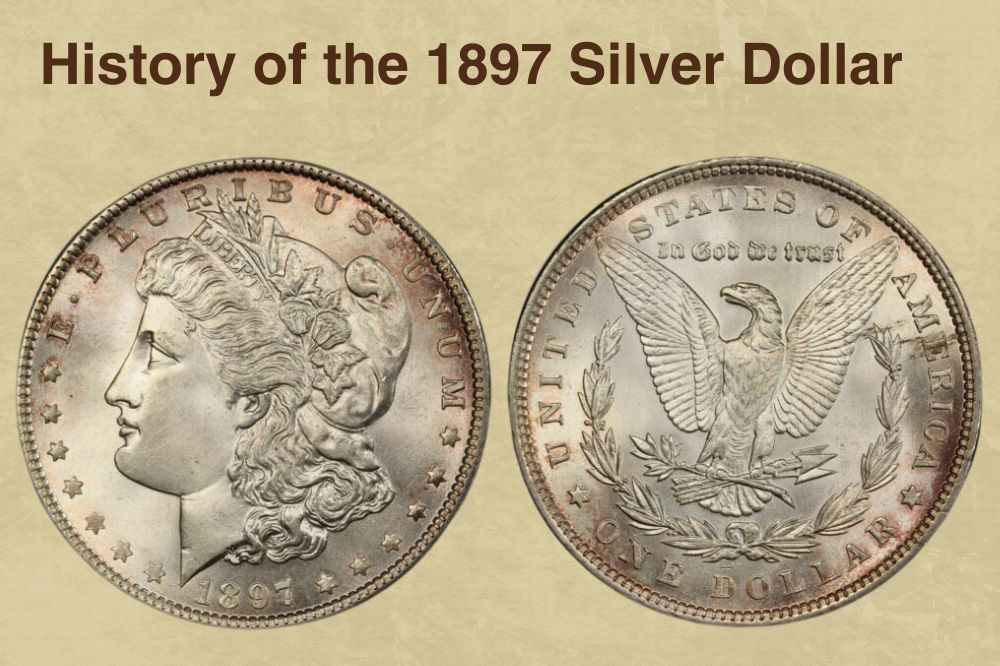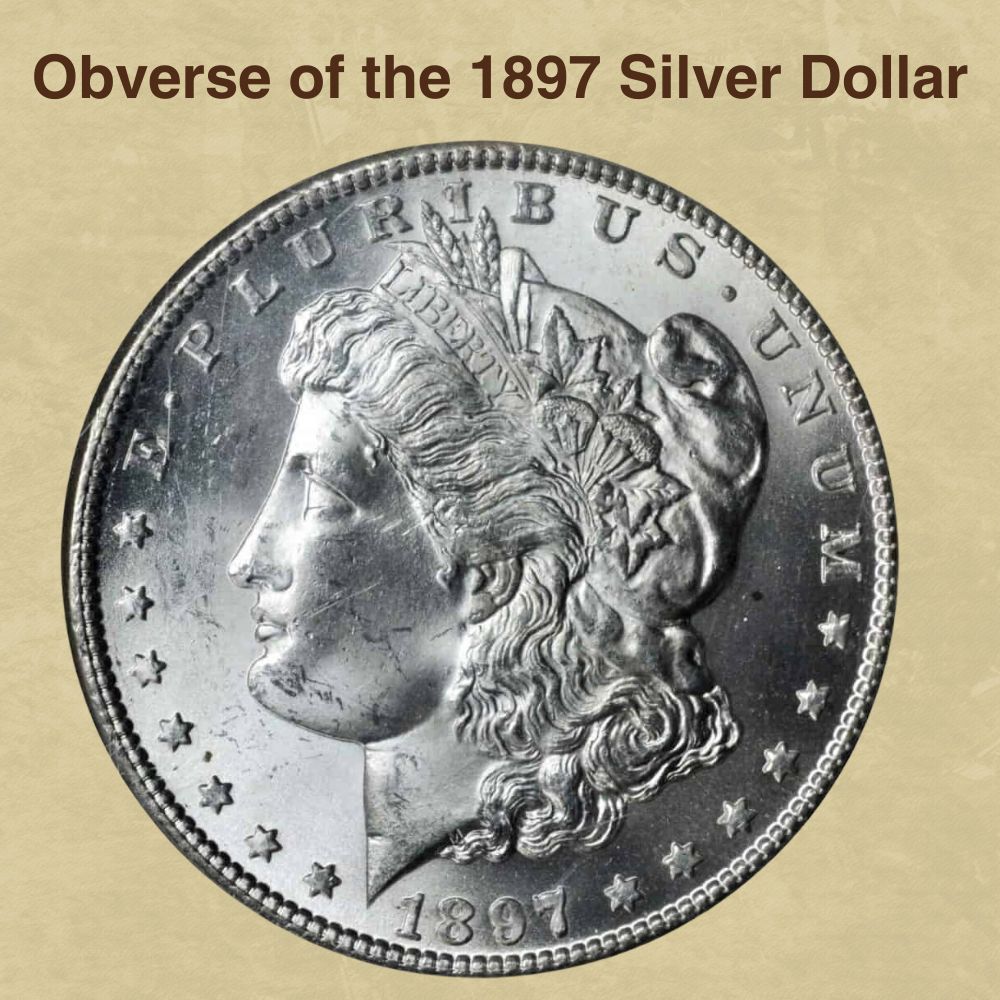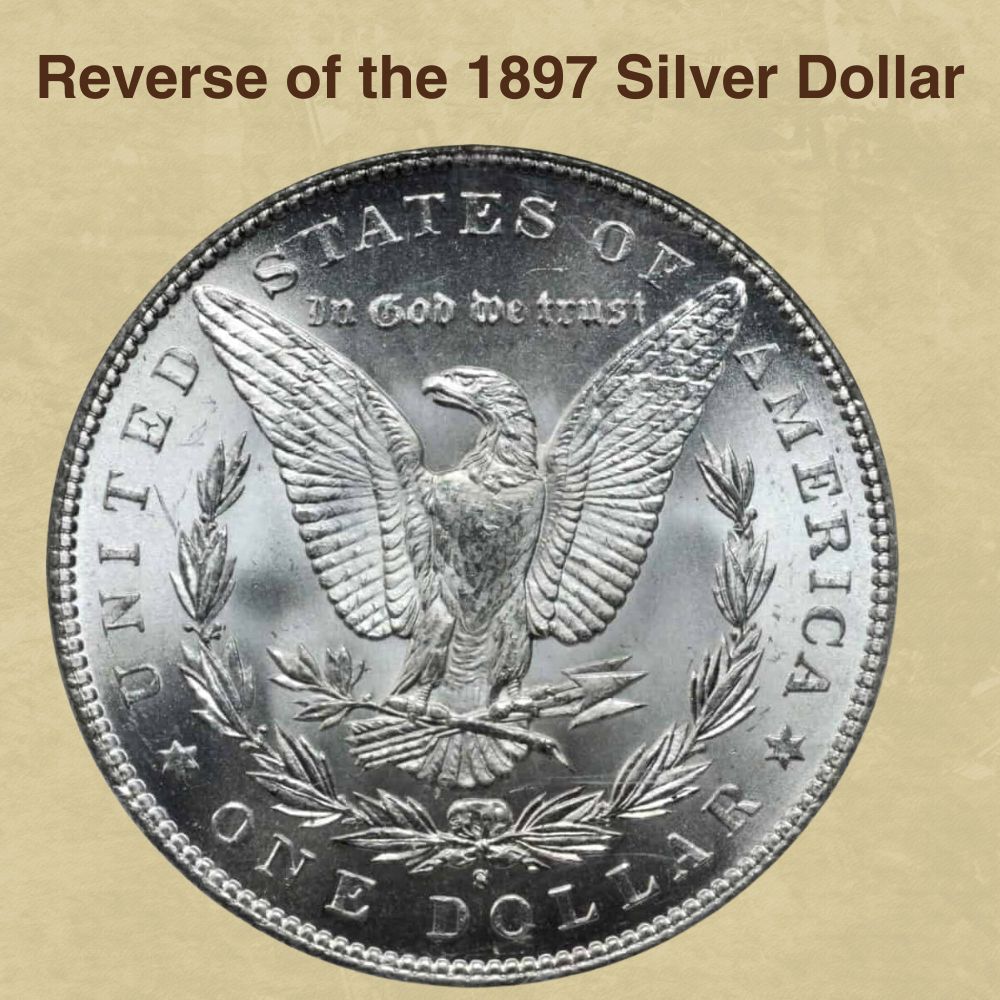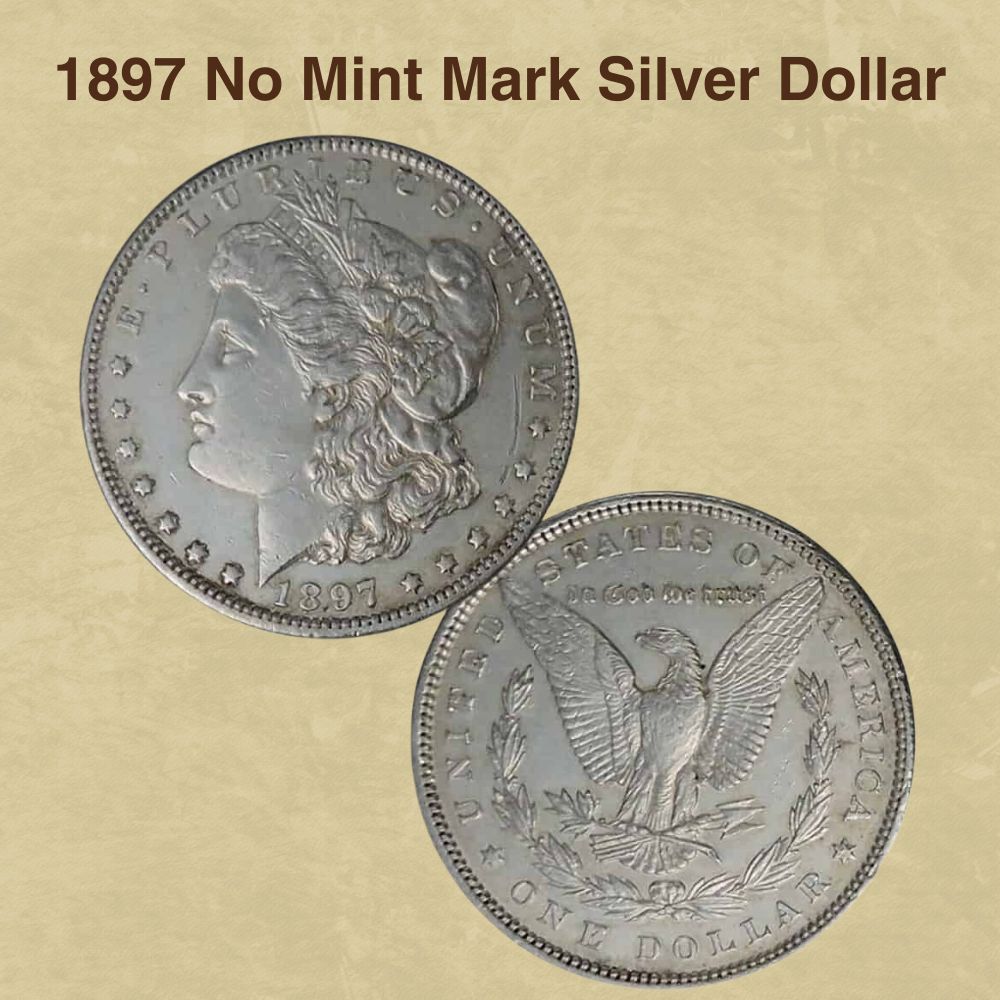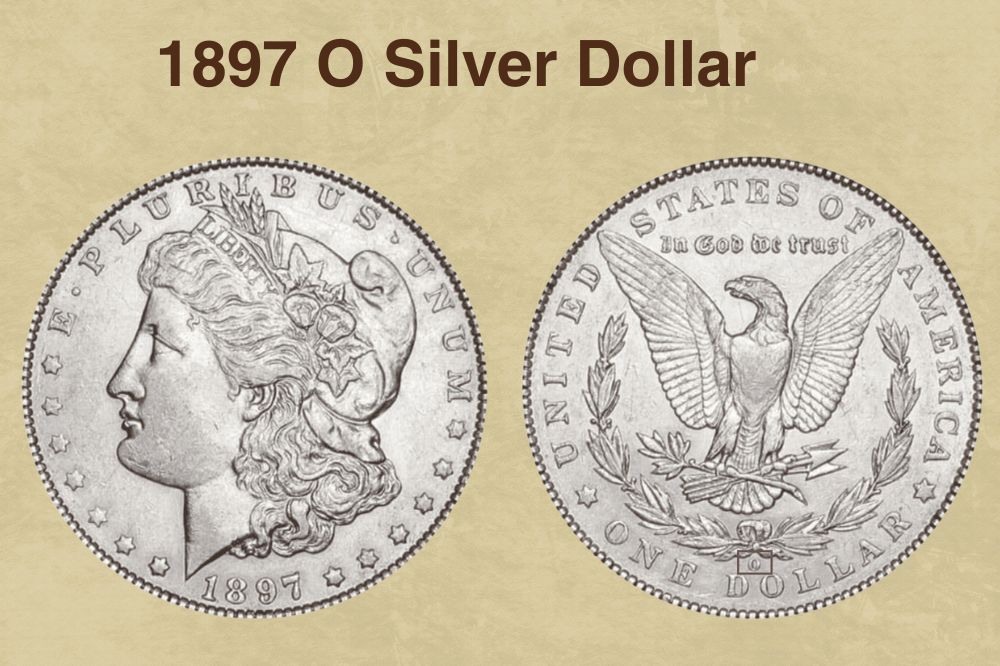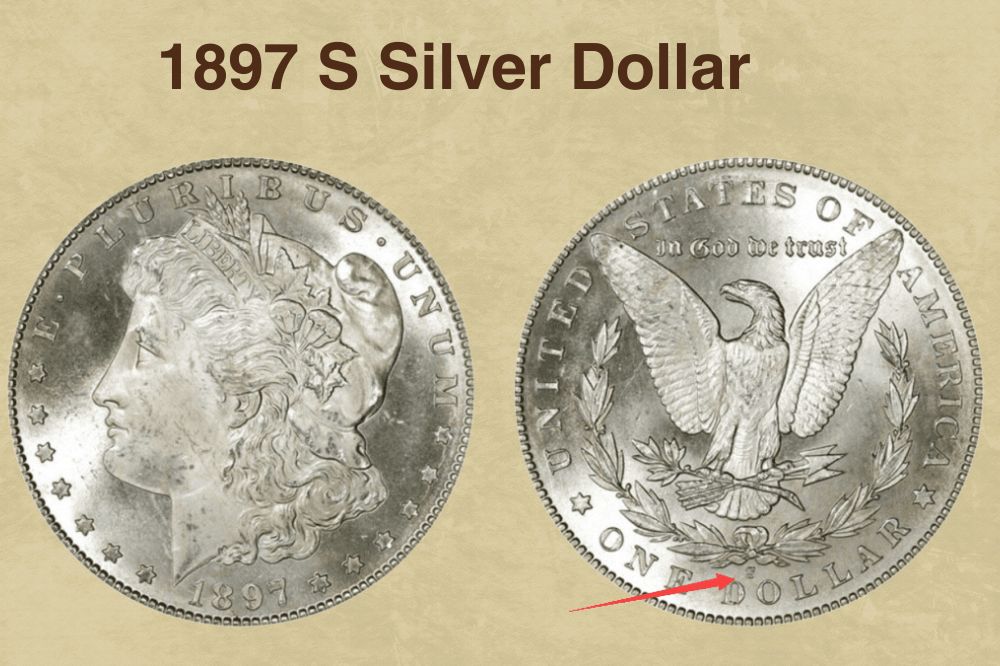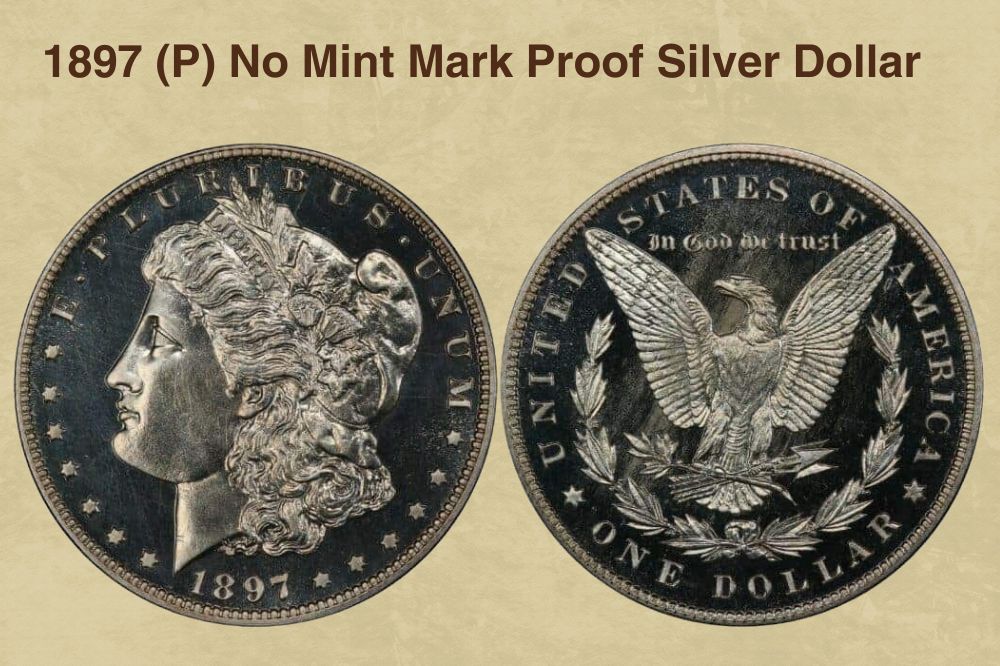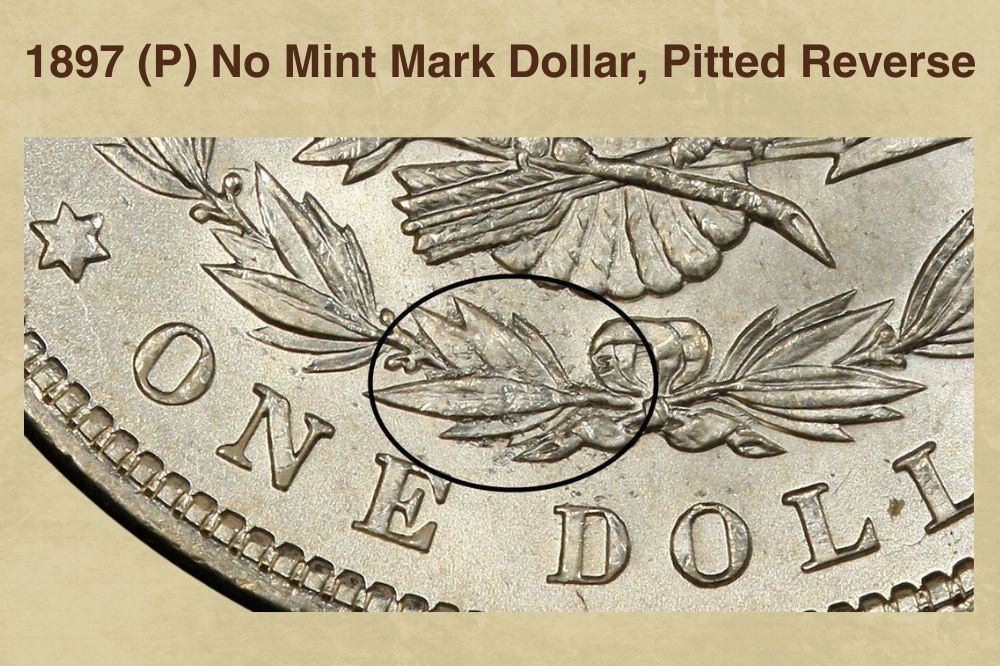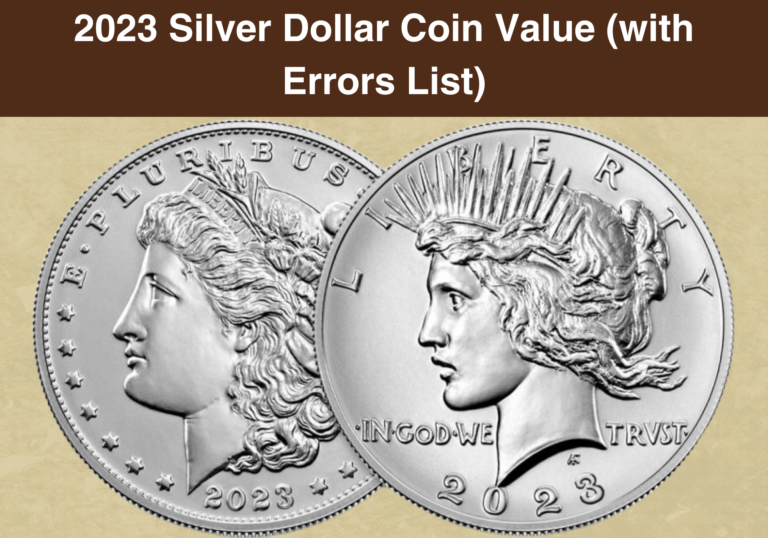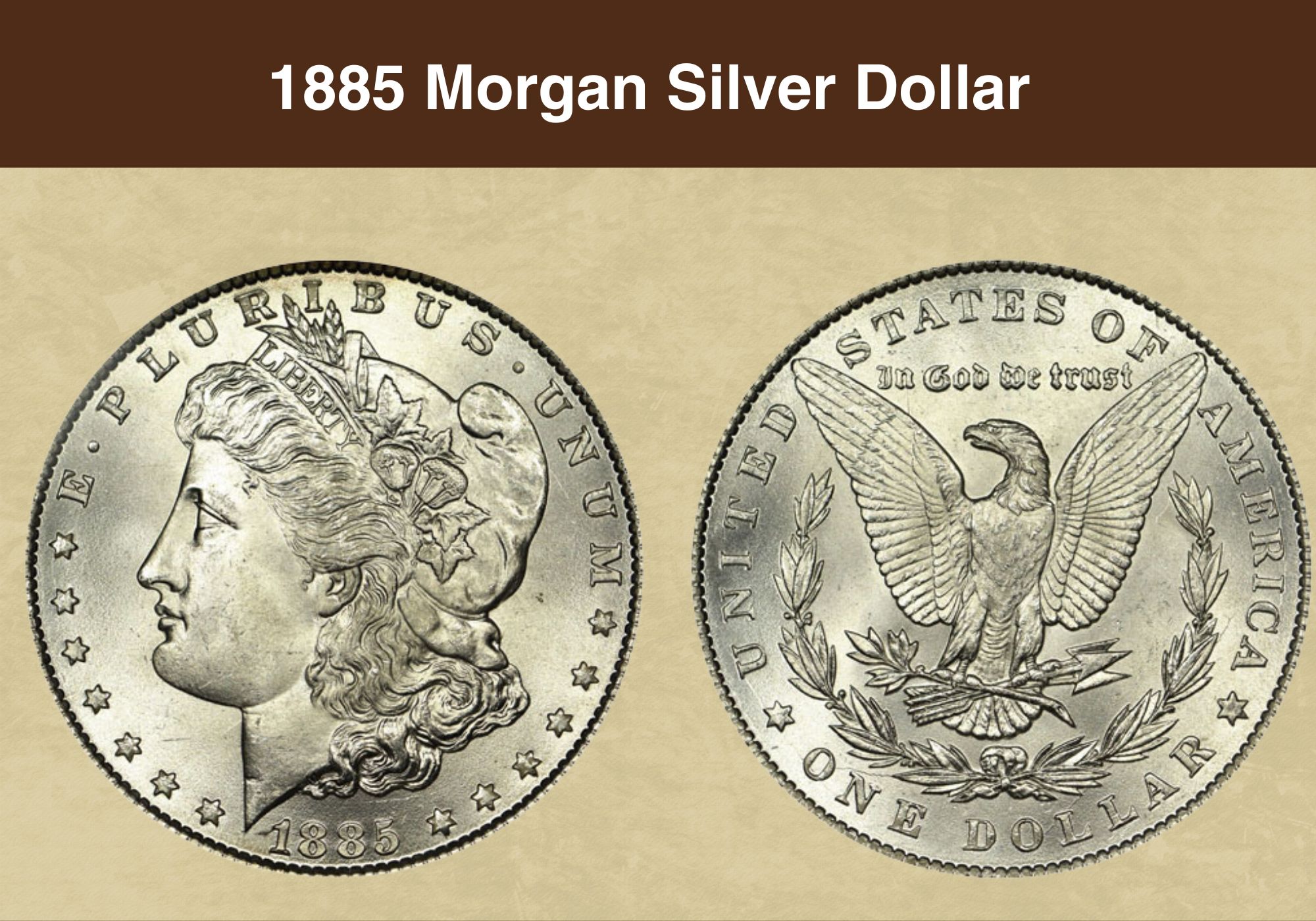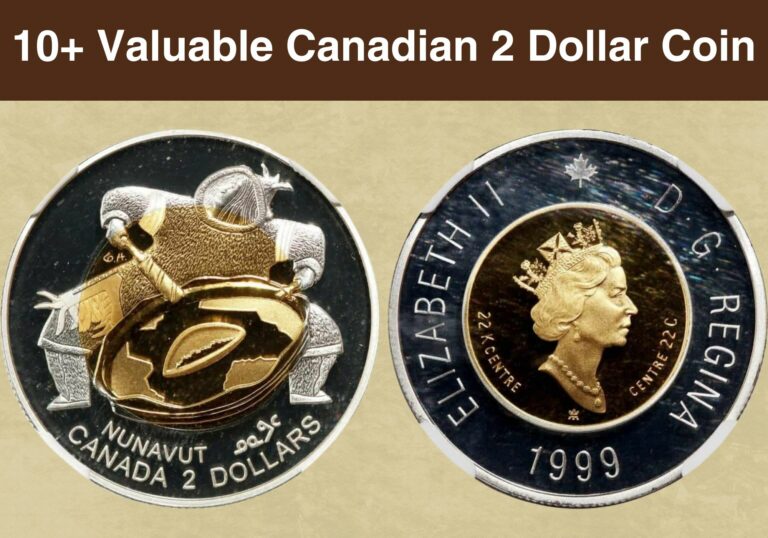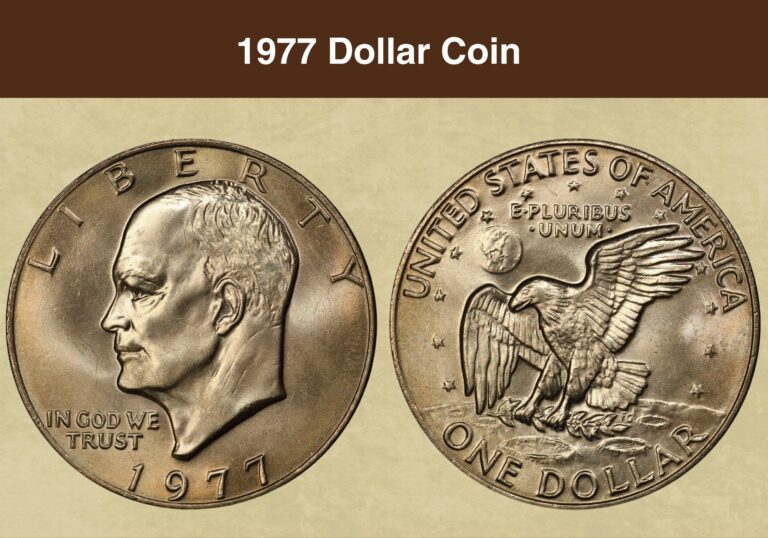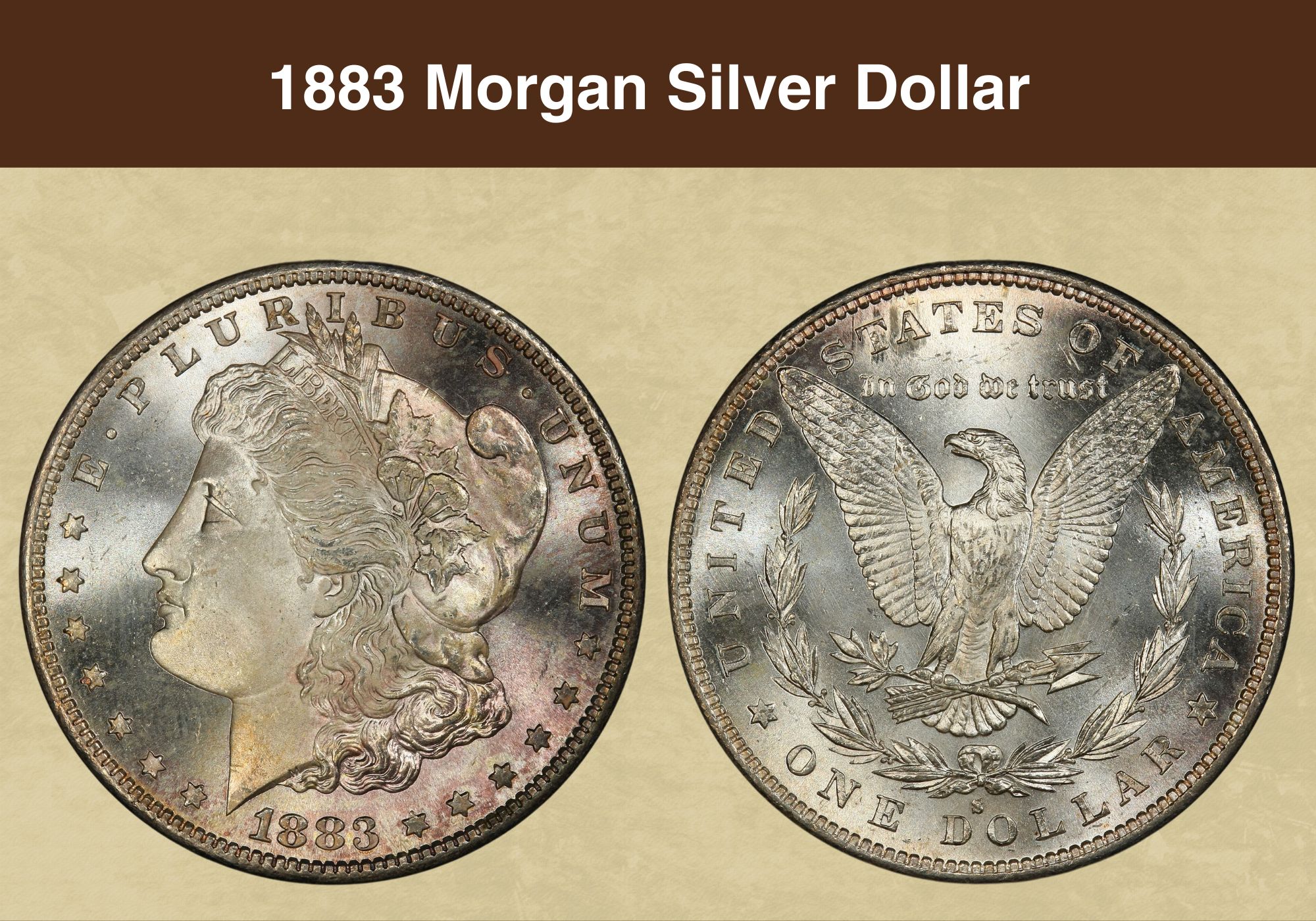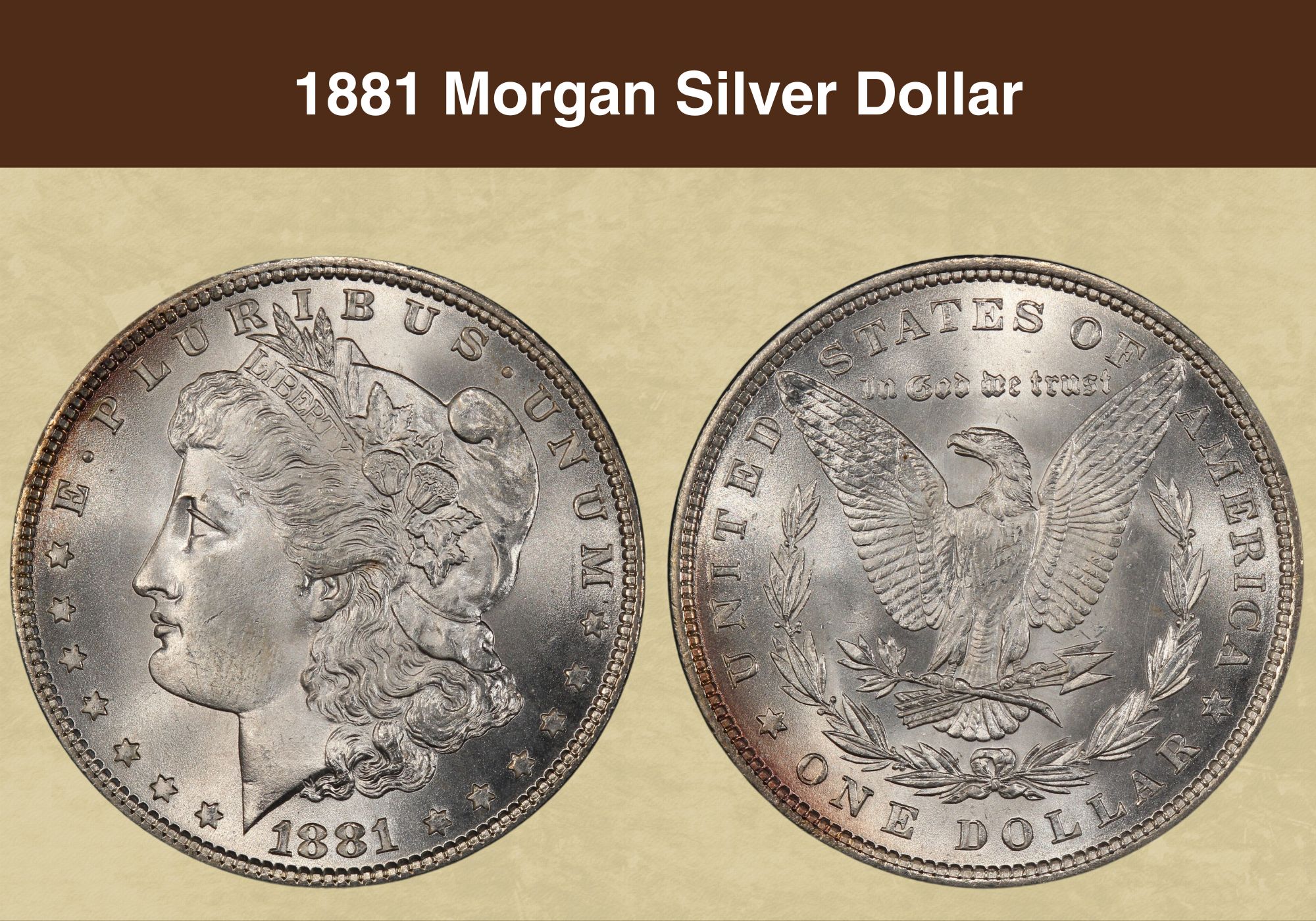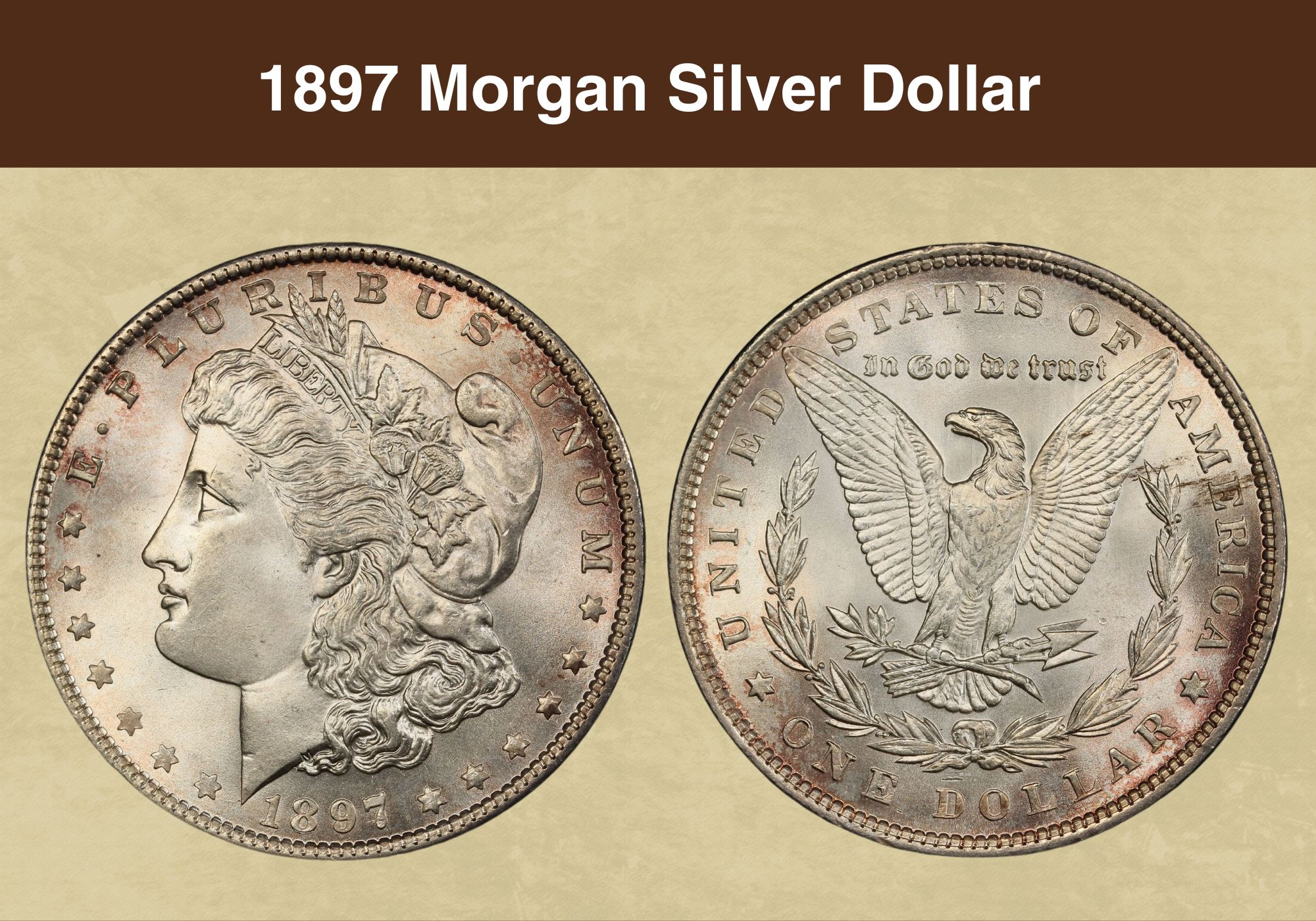
Coin Value Contents Table
- 1897 Silver Dollar Value Chart
- History of the 1897 Silver Dollar
- Features of the 1897 Silver Dollar
- 1897 Morgan Silver Dollar Grading
- 1897 Silver Dollar Value Guides
- 1897 No Mint Mark Silver Dollar Value
- 1897 O Silver Dollar Value
- 1897 S Silver Dollar Value
- 1897 (P) No Mint Mark Proof Silver Dollar Value
- Rare 1897 Silver Dollar Errors List
- Where to Sell Your 1897 Silver dollar ?
- FAQs
The silver dollars of the late nineteenth century are beautiful coins. But if you’re wondering whether they’re valuable too, you’ve come to the right place!
We’re going to look at one particular mintage, the 1897 silver dollar value. We’ll discover the impact of condition on individual coin prices. And we’ll investigate why Mint errors can be so attractive to collectors.
So if you’re ready to learn more, step this way!
1897 Silver Dollar Value Chart |
||||
| Mint mark | XF45 | MS60 | MS65 | MS67 |
| 1897 (P) No Mint Mark Silver Dollar Value | $48 | $75
Prooflike: $110 Deep Mirror Prooflike: $180 |
$350
Prooflike: $600 Deep Mirror Prooflike: $2,250 |
$5,750
Prooflike: $10,000 |
| 1898 O Silver Dollar Value | $115 | $1,350
Prooflike: $4,500 Deep Mirror Prooflike: $5,500 |
$70,000 | $385,000 |
| 1898 S Silver Dollar Value | $60 | $130
Prooflike: $125 Deep Mirror Prooflike: $175 |
$700
Prooflike: $1,150 Deep Mirror Prooflike: $3,150 |
$8,000
Prooflike: $15,000 Deep Mirror Prooflike: $50,000 |
| PR45 | PR60 | PR65 | PR68 | |
| 1897 (P) No Mint Mark Proof Silver Dollar Value | $775 | $2,200
Cameo: $2,600 Deep Cameo: $3,000 |
$7,000
Cameo: $9,500 Deep Cameo: $14,500 |
$30,000
Cameo: $70,000 Deep Cameo: $85,000 |
History of the 1897 Silver Dollar
The silver dollar struck in 1897 is what’s known as a Morgan dollar. The series was first issued in 1878 and continued in production until 1904. The name comes from its designer, George T. Morgan. But its introduction was largely the result of pressure from the mining industry.
Owners of silver mines had been lobbying hard to create a secure market for their wares. They campaigned for the Mint to be required to purchase any silver they presented to it. That silver, they argued, should be bought by the government at a set price.
The campaign was largely successful, and resulted in the Bland-Allison Act of 1878. This obliged the Mint to purchase silver to the value of between $2 million and $4 million every month. And it also required all that silver to be converted into coins.
All this meant a high volume of coin production. The 1897 mintage of Morgan dollars numbered 12.6 million coins. Today, though, numbers are much lower – and that’s not just because of the inevitable losses over the years.
German propaganda during the Second World War had led to rumors in India that British paper currency was worthless. The resulting run on silver was threatening to derail the war effort.
In 1918, the British requested assistance. The result was another piece of legislation: the Pittman Act.
This authorized silver coins to be melted down so that the silver could be sold to the British. Replacement coins would then be struck using silver purchased from American mines.
It’s believed that 90 million silver coins were melted down under the Pittman Act. And the 1897 silver dollar was considered for many years to be a rarity.
But during the 1950s and ‘60s, the Treasury released large quantities of silver dollars from its vaults. And today, the 1897 Morgan dollar is second only to the 1896 as the easiest to find in the series.
Also read: 12 Most Valuable One-Dollar Coin Worth Money
Features of the 1897 Silver Dollar
Obverse of the 1897 Silver Dollar
In 1897, it was considered unseemly, and linked to ideas of monarchy, to show a real person on a coin. The figure that appears on the “heads” side of the Morgan dollar – and most other US coins of the time – is instead Lady Liberty.
Her image was the work of the artist George T. Morgan. Only her face and neck are shown, and she is depicted in profile, facing to the left as the coin is viewed.
Earlier depictions of Liberty had shown her with Grecian features. But Morgan chose a real American woman, a teacher named Anna Willess Williams, as his model.
Above her image the Latin motto “E PLURIBUS UNUM” curves around the top half of the coin face. The words mean “From the many, one”, and they refer to the birth of the USA as a union of states.
The lower half of the design is ringed by a circle of stars, representing the states. And at the bottom, the date is inscribed in small font along the curve of the lower coin edge.
Reverse of the 1897 Silver Dollar
George Morgan also produced the design for the obverse of the Morgan dollar. It shows an eagle, the traditional emblem of the USA, with outstretched wings. A fletch of arrows and an olive branch are clutched in its talons.
Between the tips of its wings is the motto “In God We Trust”. It’s inscribed in gothic lettering, an unusual choice for American coins.
The country name curves around the top two thirds of the coin edge. It’s separated by a single star on either side from the denomination, which curves parallel to the bottom edge.
1897 silver dollars struck in Philadelphia don’t have a mint mark. But if the coin came from New Orleans or San Francisco, you’ll find an “O” or an “S” respectively on the reverse. The mark is positioned towards the bottom, just above the “D” and “O” of dollar.
Other Features of the 1897 Silver Dollar
Although they’re referred to as silver dollars, Morgan dollars also contain 10 per cent copper. They measure 38.1 millimeters in diameter and weigh 26.73 grams.
If you turn one on its side, you’ll see a series of grooves running along the edge. These are known as reeds, and they’re produced by the collar which holds the coin in place as it’s struck.
Reeded edges were used since the eighteenth century as an anti-fraud device. The pattern of grooves meant that it would be obvious if anyone had shaved precious metal from the coin edge.
This YouTube video from CoinStudy provides more detail on Morgan dollars. And it offers some helpful guidance on grading their condition.
Also read: 14 Most Valuable Coins In Circulation
1897 Morgan Silver Dollar Grading
| # | Grade |
|---|---|
| 1 | Basal State-1 |
| 2 | Fair |
| 3 | Very Fair |
| 4, 5, 6 | Good |
| 7, 8, 10 | Very Good |
| 12, 15 | Fine |
| 20, 30 | Very Fine |
| 40 | Extremely Fine |
| 50 | About Uncirculated |
| 60 | Mint State |
| 65 | Mint State |
| 70 | Mint State |
Please check our grading guides to know your coin scale, It’s the necessary step to know the exact value of your coin.
Check out now: How to Grade Morgan Silver Dollar?
1897 Silver Dollar Value Guides
1897 No Mint Mark Silver Dollar Value
The 1897 Morgan dollar is a beautiful and collectible coin. But the Treasury’s release of hundreds from its vaults in the 1950s and ‘60s mean it’s no longer the rarity it once was.
Coins are graded on a scale from 1 to 70, with 1 being poor and 70 flawless. In general, the better the condition, the more a coin will be worth. But that’s not entirely the case with Morgan dollars.
Those that show heavy signs of wear are relatively rare, because so many pristine examples appeared courtesy of the Treasury’s mid-century coin releases. As a result, coins graded 1 or 2 command a premium over other circulated coins.
An 1897 no mint mark Morgan dollar graded 2 is valued by the independent coin graders the PCGS at $70. That’s the same as the $70 value of the finest circulated example of the mintage, AU58+ (the letters stand for “about uncirculated”).
And an example graded 1 is very scarce. The PCGS places its value at an impressive $775.
That’s also much higher than many mint state examples. An MS60 is worth around $75, while at MS65 – the lowest grade at which a coin is termed a “gem” – the value is $350.
The highest prices, though are for the best-in-class coins. The finest grade to have been awarded to an 1897 Philadelphia Morgan dollar by the PCGS is MS67+. Nine coins have been certified at that level, and they’re each valued at $30,000.
There are also prooflike and “deep mirror prooflike” (DIMPL) examples. Prooflike dollars range from $110 at MS60 to $10,000 at MS67. And for DIMPL coins the range is from $180 at MS60 to $22,500 at MS66.
1897 O Silver Dollar Value
Dollars with an “O” mint mark were struck at the Mint facility in New Orleans. Just over 4 million of them were produced in 1897, and around one in ten of those survive today. Of those, the PCGS estimates 11,000 are in mint state.
Coins graded 1 or 2 carry a small premium over other circulated coins in lower grades. An 1897-O dollar graded 1 is worth around $50, and one graded 2 around $38 – close to the $42 value of a coin graded 6.
In mint state, values for a standard example start at $1,350, rising rapidly to $12,500 at MS64.
Gem coins are rare – only 38 are believed to survive. At MS65, an 1897-O dollar is worth a cool $70,000. That rises to $240,000 at MS66, and to $385,000 at MS67, the highest grade found to date for this mintage.
Prooflike coins range from $4,500 at MS60 to $14,500 at MS63. The PCGS hasn’t certified any higher, but estimates an example at MS64 would be worth $22,500.
For DIMPLs, the range is from $5,500 at MS60 to $47,500 for the two coins graded MS64.
1897 S Silver Dollar Value
The San Francisco Mint facility struck 5.8 million silver dollars in 1897. The mass smelting of the Pittman Act means that only around a tenth of those survive today. For prooflike coins, the number is around 3,400, and for DIMPLs, just 625.
Examples graded 1 or 2 command a premium over other low-graded circulated dollars. They’re valued at $55 and $37 respectively, compared to $37 to $39 for coins graded 3 to 12.
In mint state, values for standard dollars range from $130 at MS60 to $700 at MS65. You’ll need to pay almost $1,750 for an MS66 coin, and prices rise steeply from there. At MS67, the PCGS value is $8,000, and at MS67+ it’s $20,000.
The crème de la crème are three coins graded MS68, each of which are valued at $38,500.
Prooflike examples start at $125 at MS60 and enter four figures ($1,150) at MS65. The finest are four MS67 examples, worth around $15,000 apiece.
For DIMPLs, the lowest grade is also MS60, and a coin at that level is worth around $175. Prices hit four figures at MS64 ($1,850). And the finest of all is a single DIMPL certified by the PCGS at MS67 and valued at $50,000.
1897 (P) No Mint Mark Proof Silver Dollar Value
In addition to its business strike coins, the Philadelphia Mint facility struck 731 proof dollars in 1897. The low numbers mean that any of these are collectible coins.
Some, though, are designated “cameos” or “deep cameos”. These have an attractive contrast between reflective fields (the flat parts of the coin) and frosted devices (the raised parts). With deep cameos, the contrast is particularly strong. Both these designations add a premium to coin value.
Some proofs entered circulation, and as a result it’s possible to find coins graded as low as XF45. A proof at that level is valued at $775, while an AU50 example is worth $1,050.
Standard mint state coins start at $2,200, rising to $7,000 at MS65. The finest to have been certified by the PCGS are graded PR68 and are worth $30,000 apiece. If an MS69 example were to be found, the agency estimates its value at $85,000.
Cameos start at $2,600 for an example graded PR60, rising to $9,500 at PR65, and an astonishing $80,000 for the single coin certified to date at PR68+.
And for deep cameos, the range is from $5,750 at PR63 to $85,000 at PR68.
Also read: Top 10 Most Valuable Morgan Silver Dollar Worth Money
Rare 1897 Silver Dollar Errors List
1897 (P) No Mint Mark Silver Dollar, Doubled Stars
There are a huge number of different varieties among Morgan dollars. The 1897 Philadelphia mintage includes a variety known as the “Double stars”.
The different varieties are coded with VAM numbers, and this one is VAM8. It’s the result of movement during the process of manufacturing the obverse die. This led to double lines on the stars that circle the coin face. You’ll need a microscope or loupe to spot them.
The value depends on the coin’s condition. The finest example to have so far come to light is graded MS66+, but there’s no public sales information for that one. A coin graded MS64+, however, sold at auction in 2021 for over $1,400.
You can take a look at an example coin, plus other Morgan dollar varieties, in this YouTube video from Couch Collectibles.
1897 (P) No Mint Mark Dollar, Pitted Reverse
Another error affecting some of the dollars struck in Philadelphia in 1897 was a damaged reverse die.
Rust had pitted the surface, and the indentations were transferred to the coins struck by the die. The date was also further to the left than normal. This variety is coded VAM6A.
Values range from $61 for a coin graded 10, to $80 at XF45, and $135 at MS60. So far, the PCGS has certified a single example at MS66+ – and that coin is worth $2,500.
Where to Sell Your 1897 Silver dollar ?
Now that you know the value of your coins, do you know where to sell those coins online easily? Don’t worry, I’ve compiled a list of these sites, including their introduction, pros, and cons.
Check out now: Best Places To Sell Coins Online (Pros & Cons)
FAQs
What makes an 1897 silver dollar rare?
1897 New Orleans dollars were generally poorly struck – so examples with sharp detail are scarce and valuable. Anything graded MS63 and above is rare.
Coins in higher mint state grades – MS64 or MS65 and above – are relatively rare, whatever the mint mark.
And 1897 Philadelphia dollars in the very poorest condition, graded 1, are hard to find, and are worth around $1,000 apiece.
Where is the mint mark on an 1897 Morgan silver dollar?
If there is a mint mark, it will be on the reverse, below the olive branch and above the “D” and “O” of dollar. An “O” indicates the coin was struck in New Orleans, and an “S” in San Francisco.
If there’s no mint mark, it was struck in Philadelphia, which didn’t use mint marks at that time.

